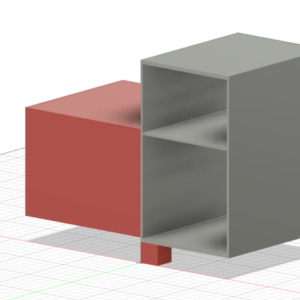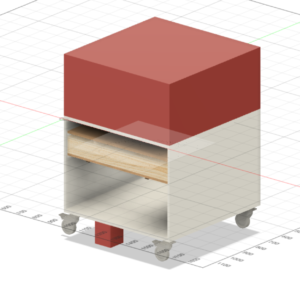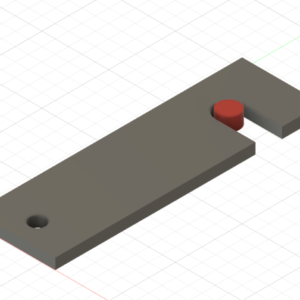I am currently making some mobile cabinets for the workshop. The first will hold a Dewalt DWE7491-XE contractor saw and the second will be a router unit. There will also be an additional extension unit to hold other tools.
The plan is that I will be able to use / store them separately but also to connect them to provide additional work support.
The extension table will be able to connect to the back or front of the table saw unit to provide either out-feed or in-feed. The router table will fit on either left or right to provide additional work support.
The issue is I need a method to connect the units together accurately to ensure they are aligned. I have though about a pivoted hook as shown in attachment on base of units which connect with pin or screw on table saw unit. This would align the base, then perhaps some screws and inserts in the sides to tie the tops in.
Does anyone have any better / clever ways of doing this?

















Replies
How precise do you need?
If you need a large, 'truly flat' work surface for assembly say, you will struggle to achieve this consistently with dockable units.
The only way I can think of you getting consistent connection is a system where you physically interlock the units in some way, but doing so accurately is remarkably difficult. Even lego, which is very precisely made is difficult to get to align perfectly, and of course the mechanism for mating takes up space. If you make mating lugs that are precise enough to ensure a flat top surface, you end up with them being almost impossible to get to go together, especially when heavy and loaded and you are on your own...
What you propose will work in a way, but will never be as precise as you imply is needed. You will struggle to get the tops co-planar and level with each other.
You could of course include the ability to adjust the tops, but it would I think be more fun trimming your grass with nail scissors.
If total flatness is needed and space is at a premium, why not just link your boxes and lay a cheap hardboard torsion-box door over them. These cost bugger all and are easy to store out of the way when not in use.
If you have space, something like the woodwhisper's assembly table (on which you could easily butcher an elephant) or woodshop junkie's all in one is better: https://woodworkjunkie.com/product/woodshop-junkies-all-in-one-woodworking-bench-plans
This latter is a great idea with the tools you mention included in a table with flip-tops.
Stumpy nubs is also promising plans for a modular assembly table soon - perhaps wait and see what he comes up with as it's mostly innovative.
It doesn't need to be assembly table flat as this is more work support for sheets or large goods on table saw.
Yes the other issue is the space taken up by locating features. I don't want anything permanently sticking out because I have recently moved house (which was a nightmare with the movers) so I want the units to be able to be shipped securing everything inside (the saw will come off it's unit and go back in box)
I plan to build a seperate assembly table as a single unit.
I am trying to divide the units up by "tool types" i.e. saw unit with table saw, jig saw, skill saw etc. Finishing unit with router, trim router, belt, orbital and detail sander etc...
How big are the boxes? If they are put together only occasionally for short-term use you could take the K.I.S.S. route and just use a couple of pipe clamps.
Small unit is 680mm(W) x 700mm(L) x 496 (H) less saw.
Large Unit is 520mm (W) x 700mm (L) x 816mm (H).
They are designed so tops sit at 950mm total height.
I did think about clamps but I wanted something more elegant.
I also failed to note that the bases will be at different heights due to different wheel sizes, therefore my orignal clamping plan would be harder to implement.
I had another idea last night though: I was looking at a quick change tool post on the lathe, and wondered if a dovetail solution may work turned 90 degrees.
Perhaps if the bottom rail was fixed and the top on pivoted so it could be used to clamp down and pull to units together?
I realise that there is now a gap I need to overcome and not everything is flush and tidy on the sides; but I am just trying to keep it simple.
It would be similar to 2 french cleats, but one inverted?
To clarify a little; the following pictures show what I mean by reconfiguring the units for support on what side is required. The saw sits on top of the small unit to bring the top surfaces level
A while back, I build four open cabinets as a right out feed table for my miter saw. I connected these cabinets together with Connector Bolts like these:
https://www.menards.com/main/kitchen/kitchen-cabinets/klearvue-cabinetry/kl-eumlarve-cabinetry-trade-cabinet-connector-bolts-12-pack/450-80-215/p-1450446290533.htm
The base cabinets with shelves hold a ton of storage for handheld power tools (nail guns, routers, etc). The top has a Kreg stop set-up for the saw. The whole, very long unit is on wheels (although I rarely move it anywhere).
I quite like the look of those; I take it the metal part to screw into would help with aligning cabinets as well?
This is the idea of the dovetail / cleats I had. I have drafted some internal ones. The advantage is that they maintain the original spacing so I don't have to cover a gap between the saw top and next unit.
The downside is that they take up space inside unit, are more complex to build, and I feel may be quite difficult to prevent binding when fitting together?
Oh, I change orientation of router table to allow better access...
Next I will draft external ones.
Here are the designs for external dovetail / cleats. With these, I would line the units up using the fixed bottom cleat and then clamp in with the top cleat pushing the dovetails together.
Any thoughts on which, if any would work better?
Or am I better just sticking to the cabinet bolts mentioned earlier?
The cabinet bolts are a pretty fixed solution. You might need to empty the boxes each time you want to reconfigure.
“[Deleted]”
I did have another idea. This time attaching small ledges on the external units which go above and below saw unit . These could then either be screwed into fixings with star wheels as a clamp of sorts, or maybe latches to pull them in?
This forum post is now archived. Commenting has been disabled